The PM Awas Yojana Urban 2.0 (PMAY-U 2.0) is a government scheme that aims to provide affordable housing for everyone living in urban areas. This scheme focuses on helping people from economically weaker sections (EWS), lower-income groups (LIG), and middle-income groups (MIG).
The mission will run for five years, starting from September 1, 2024, and it offers support for building, buying, or renting homes. There are four main parts of this scheme:
- Beneficiary Led Construction (BLC)
- Affordable Housing in Partnership (AHP)
- Affordable Rental Housing (ARH)
- Interest Subsidy Scheme (ISS)
The scheme also encourages female ownership. Most houses built under this program are registered in the name of the female head of the family or jointly in both partners’ names.
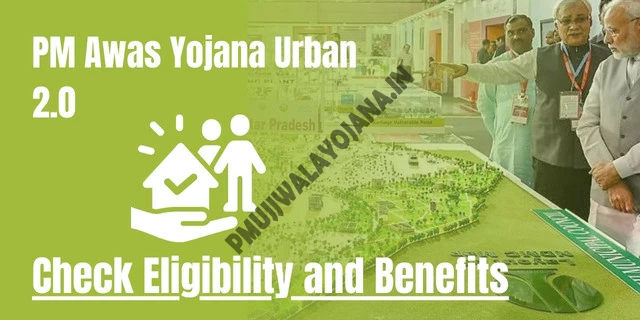
Basic civic amenities such as water, electricity, and sanitation are mandatory, and additional provisions like rainwater harvesting and solar energy systems are encouraged. States and UTs are responsible for local infrastructure and can adjust house sizes within the government’s financial constraints. The scheme also mandates inclusive measures like accessibility for Persons with Disabilities and the promotion of environmental sustainability.
About PM Awas Yojana Urban 2.0
PM Awas Yojana Urban 2.0 (PMAY-U 2.0) is an extension of the government’s flagship “Housing for All” mission, aiming to provide affordable housing in urban areas from September 1, 2024, for five years. Under this scheme, States and Union Territories (UTs) manage local infrastructure and have flexibility in adjusting house sizes between 30 to 45 square meters. The scheme not only aims to provide housing but also focuses on improving the quality of life for urban residents by promoting environmentally friendly and socially inclusive housing solutions.
The scheme will continue to cover cities and towns that were already part of PMAY-U, ensuring ongoing support under PMAY-U 2.0. Additionally, cities and towns which are not previously included in PMAY-U can now be added, subject to approval by the Ministry of Housing and Urban Affairs (MoHUA). This overall approach ensures that all eligible urban areas receive support for affordable housing development, covering new towns as well as those already involved in the mission, allowing for wider reach and impact across urban India.
Helpful Highlights of PM Awas Yojana Urban 2.0
| Name of the Scheme | PM Awas Yojana Urban 2.0 |
| Launched By | The Government of India |
| Introduced By | Ministry of Housing and Urban Affairs, Government of India |
| Scheme Duration | 5 years (Starting from September 1, 2024) |
| Eligibility | Urban families without a pucca house in any part of India, targeting EWS, LIG, and MIG segments |
| House Ownership | Houses registered in the name of the female head or jointly with her husband |
| House Size | 30 square meters carpet area, extendable to 45 square meters by States/UTs |
| Basic Amenities | Water, sanitation, electricity, roads, and sewerage |
| Additional Provisions | Rainwater harvesting, solar energy systems, barrier-free access for Persons with Disabilities (Divyangjan) |
| Verticals | 1. Beneficiary Led Construction (BLC) 2. Affordable Housing in Partnership (AHP) 3. Affordable Rental Housing (ARH) 4. Interest Subsidy Scheme (ISS) |
| Beneficiary | Economically Weaker Sections (EWS), Low-Income Groups (LIG), Middle-Income Groups (MIG) |
| Benefits | This scheme provide affordable housing facility to the urban poor |
| Objective | To provide affordable housing for all in urban areas |
| State | All states of India |
| Year | 2024 |
| Hosting Site | NIC (National Informatics Center) |
| Mode of Application | Online/Offline |
| Official Website | https://pmaymis.gov.in/ |
PM Awas Yojana Urban 2.0 Objective
The objectives of the scheme are as follows:
- The primary objective of launching the scheme is to provide affordable housing facilities to urban residents.
- The scheme ensures access to affordable housing for all urban residents, particularly those from Economically Weaker Sections (EWS), Low-Income Groups (LIG), and Middle-Income Groups (MIG).
- It prioritize women’s ownership of homes by ensuring houses are registered in the name of the female head of the household or jointly with her spouse.
- It ensures housing is inclusive and accessible, with special provisions for Persons with Disabilities (Divyangjan) and vulnerable groups.
- The scheme aims to provide houses with essential services like water, sanitation, electricity, roads, and sewage systems to enhance the quality of life.
- The scheme aims to strengthen urban infrastructure, improve living conditions, and promote economic development through affordable housing initiatives.
Coverage Under PMAY Urban 2.0
Coverage under the scheme is as described below:
- Under PM Awas Yojana Urban 2.0, all towns listed as statutory towns in the 2011 Census, as well as towns notified afterward, are covered by the scheme. This also includes areas that fall within Notified Planning Areas or Development Areas managed by authorities such as Industrial Development Authorities, Special Area Development Authorities, or Urban Development Authorities. These authorities are responsible for urban planning and regulations as per state laws.
- Cities and towns already included in the original PMAY-U scheme will continue to be covered under PMAY-U 2.0. New cities and towns that were not previously part of the scheme can also be added with the approval of the Ministry of Housing and Urban Affairs (MoHUA). This ensures the scheme’s broad coverage across all urban areas for all its components, providing affordable housing to a wider population.
Eligibility Criteria
To avail the benefits under the scheme, you should satisfy the following requirements, which are as follows:
- The applicant should be a permanent resident of India.
- EWS, LIG, and MIG families in urban areas without a pucca house can apply under PM Awas Yojana Urban 2.0.
- Beneficiaries can access any PMAY-U 2.0 vertical, but those who received housing assistance in the last 20 years are ineligible. An undertaking may be required.
- EWS households earn up to Rs. 3 lakh, LIG from Rs. 3 to Rs. 6 lakh, and MIG from Rs. 6 to Rs. 9 lakh annually. States/UTs can adjust EWS income limits with MoHUA’s approval.
- Priority will be given to widows, single women, persons with disabilities, senior citizens, transgenders, SC/ST individuals, minorities, and other vulnerable groups, including street vendors and construction workers.
- If a beneficiary’s parents received a pucca house from prior schemes, the beneficiary will only be considered after other eligible families.
- Beneficiaries can choose between PMAY-G (Gramin) and PMAY-U 2.0 to avoid duplication.
- All eligible beneficiaries must have an Aadhaar card or Aadhaar Virtual ID. States/UTs must assist those without Aadhaar to enroll.
- A committee at the district or ULB level, led by the District Magistrate or Municipal Commissioner, will select beneficiaries, with two public representatives nominated by the government.
Silent Features
Salient Features of PMAY-U 2.0 are as follows:
- The scheme provides housing for all urban residents, particularly EWS, LIG, and MIG categories.
- Verticals of Implementation:
- Beneficiary Led Construction (BLC)
- Affordable Housing in Partnership (AHP)
- Affordable Rental Housing (ARH)
- Interest Subsidy Scheme (ISS)
- Houses are to be registered in the name of the female head of the household or jointly.
- The scheme ensures essential services like water, sanitation, electricity, and roads are provided in housing projects.
- The minimum carpet area of 30 square meters, with flexibility to expand up to 45 square meters.
- Priority for vulnerable groups, including widows, persons with disabilities, senior citizens, and marginalized communities.
- Income Criteria:
- EWS: Up to Rs. 3 lakh
- LIG: Rs. 3 lakh to Rs. 6 lakh
- MIG: Rs. 6 lakh to Rs. 9 lakh
- Includes all statutory towns and notified planning areas, with potential expansion to new areas.
- Beneficiaries must have Aadhaar or Aadhaar Virtual ID for eligibility.
- A district/ULB level committee will be responsible for beneficiary selection, ensuring transparency and fairness.
PM Awas Yojana Urban Implementation Process
PM Awas Yojana Urban Implementation Process follows as:
- To access Central Assistance under PMAY-U 2.0, States/UTs must implement reforms and create an Affordable Housing Policy. They will sign a Memorandum of Agreement (MoA) with the Ministry of Housing and Urban Affairs, committing to various incentives for affordable housing as specified in the scheme guidelines.
- After signing the MoA, States/UTs will submit proposals to the Ministry for including new statutory towns and cities under PMAY-U 2.0, excluding those already approved under the previous PMAY-U scheme.
- The Urban Local Body (ULB) or the designated state agency will act as the main agency for implementing the scheme in a city. Development authorities and other related agencies must submit their proposals for approval to the State Level Appraisal Committee (SLAC), State Level Sanctioning and Monitoring Committee (SLSMC), and Central Sanctioning and Monitoring Committee (CSMC) through the respective ULB.
- States, UTs, and cities will conduct a quick assessment of housing demand across different categories to determine actual needs. Beneficiaries can register for housing demand on a unified web portal. States/UTs/ULBs will validate these registrations based on eligibility criteria, ensuring to exclude families with pucca houses in rural areas who have moved to cities to benefit from PMAY-U 2.0.
- States, UTs, and Urban Local Bodies (ULBs) should identify beneficiaries from Special Focused Groups (SFGs) as outlined in the guidelines. These groups will be given priority for inclusion in PMAY-U 2.0, ensuring they receive benefits accordingly.
- Cities will create a City-wise Housing Plan on the Unified Web-portal based on demand assessment and available data. This plan will detail the total and annual housing demand for eligible beneficiaries across different verticals, following the guidelines outlined in Annexure-4.
- The construction progress of houses under PMAY-U 2.0 will be monitored using Geo-tagging at five key stages: layout, foundation/plinth, lintel, roof, and completion.
- Central Assistance for the Affordable Housing in Partnership (AHP) and Beneficiary Led Construction (BLC) verticals will be disbursed to States and UTs in installments, contingent upon the Geo-tagging status of the projects. Experts at the Urban Local Body (ULB) level will capture the spatial location data. The Ministry will reimburse expenses related to Geo-tagging for various projects based on the established funding pattern.
- States and UTs should aim to finish all houses approved under PMAY-U 2.0 within the timeline set in the Detailed Project Report (DPR). To support this, they can offer incentives to beneficiaries, including increased financial aid and access to subsidized construction materials.
- Under the scheme, there is a mandatory lock-in period of five years. This applies from the completion date of a house built under the Beneficiary Led Construction (BLC) scheme, the possession date of a house under the Affordable Housing in Partnership (AHP), or the first disbursement of a home loan under the Interest Subsidy Scheme (ISS). During this period, beneficiaries cannot sell or transfer their house.
- States/UTs can propose row housing projects under the Affordable Housing in Partnership (AHP) vertical, ensuring all basic amenities and social infrastructure are provided.
- The mission will conduct national Information, Education, and Communication (IEC) activities to promote the scheme. States/UTs/ULBs will also hold local awareness events and must display the PMAY-U 2.0 logo at housing units.
- States/UTs are encouraged to inform stakeholders about innovative construction technologies that improve thermal comfort, energy efficiency, and disaster resilience while being cost-effective.
- The Central Sanctioning and Monitoring Committee (CSMC) will handle all necessary approvals related to the scheme and assist States/UTs/ULBs in overcoming implementation challenges. Changes in capacity-building norms will also be managed by the CSMC.
Verticals Under Pradhan Mantri Awas Yojana Urban 2.0
The verticals under PM Awas Yojana Urban 2.0 are as follows:
- Beneficiary Led Construction (BLC)
- Affordable Housing in Partnership (AHP)
- Affordable Rental Housing (ARH)
- Interest Subsidy Scheme (ISS)
Beneficiary Led Construction (BLC)
The BLC vertical of PMAY-U 2.0 provides financial assistance to economically weaker section (EWS) families to construct new pucca houses on their own land. For landless beneficiaries, states/UTs may grant heritable, non-transferable land rights (pattas) to qualify for assistance. Eligible houses must be between 30 sqm and 45 sqm, adhering to National Building Code (NBC) standards and featuring at least two rooms, a kitchen, and a toilet/bathroom. Beneficiaries must apply through Urban Local Bodies (ULBs) or a Unified Web Portal, submitting necessary documents, including land ownership proof.
Implementing agencies will validate applications and prepare city-wide proposals for approval by State Level Sanctioning and Monitoring Committees (SLSMC). Central assistance is disbursed in three installments (40:40:20) based on construction progress, with funds released via Direct Benefit Transfer (DBT). States/UTs are required to provide matching financial contributions. Additionally, beneficiaries can geo-tag their construction progress for monitoring, and all houses must be completed within 12-18 months of project sanction. This initiative aims to enhance housing availability and improve living conditions for EWS families.
Affordable Housing in Partnership (AHP)
The AHP vertical of PMAY-U 2.0 aims to provide financial support to economically weaker section (EWS) families for owning pucca houses constructed through partnerships with states, cities, or private agencies. This initiative focuses on building affordable houses with a carpet area of 30-45 sqm. States/UTs can develop projects either through government agencies or in collaboration with private partners. The minimum booking amount is required from beneficiaries to ensure participation. The sale price of houses is capped to keep them affordable. Each project must include at least 25% EWS houses, with a minimum of 100 such houses to qualify for central assistance.
Projects should use sustainable building materials and adhere to green building standards. All approvals for projects must be obtained within three months, and completion is expected within 24-36 months. Houses are allocated through a transparent process, prioritizing families with disabilities or senior citizens for ground-floor units. Additionally, projects using innovative technologies can receive extra funding. All AHP projects must be registered under the Real Estate (Regulation and Development) Act, 2016 (RERA).
Affordable Rental Housing (ARH)
The Affordable Rental Housing (ARH) vertical aims to encourage public and private entities to invest in creating affordable rental housing for various urban groups, including economically weaker sections (EWS), lower-income groups (LIG), and migrants. This initiative targets those who prefer renting instead of owning a home, such as industrial workers, construction workers, and street vendors. ARH will ensure that rental homes are affordable and hygienic, providing necessary amenities like water, sanitation, and community facilities to make them livable.
States and urban local bodies (ULBs) are responsible for addressing any gaps in civic infrastructure. Rental units will be used solely for housing and managed by ULBs or partnering entities. Rent collection can be facilitated through salary deductions for tenants. Municipal services like water and sewage charges will be applied similarly to residential projects. Details about available rental units, including project specifics and occupancy rates, will be updated daily on a unified web portal and the websites of the respective ULBs.
Interest Subsidy Scheme (ISS)
The Interest Subsidy Scheme (ISS) is a central initiative aimed at boosting affordable housing by providing financial assistance on home loans. It offers subsidies to eligible beneficiaries from the Economically Weaker Sections (EWS), Lower Income Groups (LIG), and Middle Income Groups (MIG) for purchasing, repurchasing, or constructing homes. Eligibility is based on annual income: up to Rs. 3 lakh for EWS, Rs. 6 lakh for LIG, and Rs. 9 lakh for MIG. Beneficiaries can receive an interest subsidy of 4% on loans up to Rs. 25 lakh for houses valued at up to Rs. 35 lakh. The maximum benefit is Rs. 1.80 lakh, paid in five yearly installments. To qualify, applicants must provide proof of income, and the subsidy is available only once per property.
If the property is sold, the new owner cannot claim the subsidy. Loans must be linked to the beneficiary’s Aadhaar ID to prevent duplication of benefits. The Central Nodal Agencies (CNAs) will facilitate subsidy distribution through participating lenders (PLIs). Once the loan is approved, the subsidy is credited directly to the borrower’s account. PLIs must charge interest based on the reducing balance method. All housing projects must be geo-tagged, ensuring proper tracking and accountability. The scheme also promotes awareness through loan melas and information displays at banks to assist applicants in accessing these benefits effectively.
PMAY Urban 2.0 Funding Pattern
The funding for different verticals of PM Awas Yojana Urban 2.0 involves contributions from the Central Government, State Governments, and beneficiaries. The amount varies based on the state or union territory, with specific minimum requirements for each category. Additional grants are available for innovative construction methods, and agencies can access loans to support housing construction.
| Sl. No | States/UTs | BLC & AHP | ARH | ISS |
| 1 | Assam, Arunachal Pradesh, Meghalaya, Manipur, Mizoram, Nagaland, Tripura, Sikkim, Himachal Pradesh, Uttarakhand, UTs of Jammu and Kashmir, Puducherry, Delhi | Central Govt.: Rs. 2.25 lakh/Unit State Govt.: Min. Rs. 0.25 lakh/Unit |
Central Govt.: Rs. 3,000/sqm State Govt.: Rs. 2,000/sqm |
Up to Rs. 1.80 lakh (Actual Release) |
| 2 | All other UTs | Central Govt.: Rs. 2.50 lakh/Unit | ||
| 3 | All other States | Central Govt.: Rs. 1.5 lakh/Unit State Govt.: Min. Rs. 1.00 lakh/Unit |
Fund Sanctioning Process Under PM Awas Yojana Urban 2.0
Fund Sanctioning processes under PM Awas Yojana Urban 2.0 are as follows:
- States/UTs identify eligible projects for affordable housing under PM Awas Yojana Urban 2.0.
- Implementing agencies prepare a DPR, including project details, beneficiary list, layout plans, and estimated costs.
- The DPR is submitted to the State Level Sanctioning and Monitoring Committee (SLSMC) for approval.
- Once approved, the state submits a proposal for Central Assistance to the Ministry of Housing and Urban Affairs (MoHUA).
- Upon reviewing the proposal, MoHUA sanctions the funds based on the established guidelines and criteria.
- The sanctioned amount is released to the state or implementing agency through Direct Benefit Transfer (DBT).
- The implementing agency commences construction or other project activities as per the approved plan.
- Regular monitoring and evaluation of the project’s progress are conducted by SLSMC and MoHUA to ensure compliance and timely completion.
- Projects are geo-tagged, and periodic reports are submitted to track progress and fund utilization.
- Upon completion, houses are allotted to eligible beneficiaries following a transparent process.
Pradhan Mantri Awas Yojana Urban 2.0 Apply Online
To apply for the scheme, please follow the below-mentioned steps:
Step 1: Visit the official PMAY website.
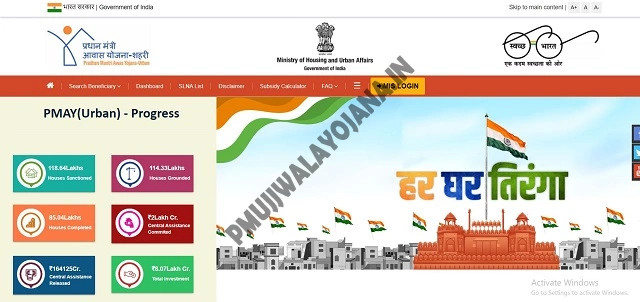
Step 2: On the homepage click on the “Apply Now” option or click on the link given below
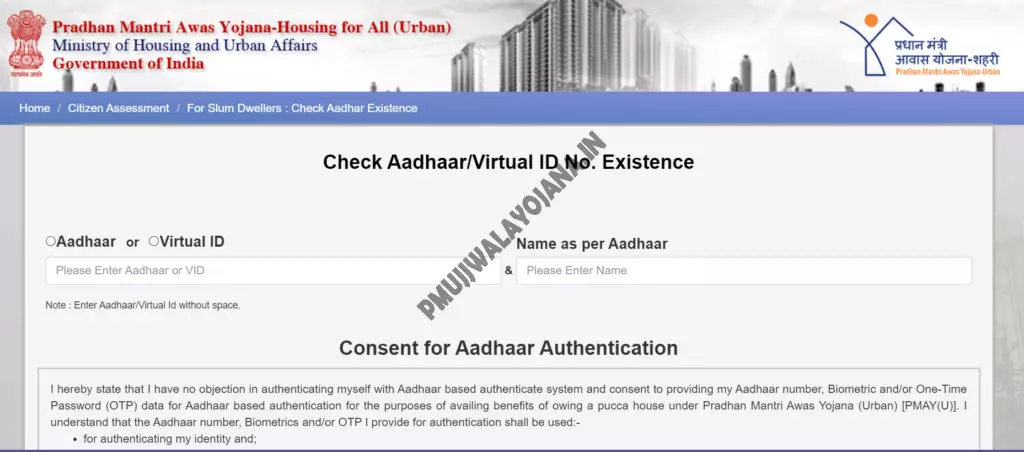
Step 3: A new page with appear on your desktop screen, the applicants must enter their Aadhar number or virtual ID tick the consent box and click on “Check” button.
Step 4: Now the application form will appear on your desktop screen the applicant must enter all the details that are asked and attach all the necessary documents.
Step 5: After entering all the details, the applicant must review the form.
Step 6: Click on the “Submit” button to complete the application process.
Search Beneficiary in PM Awas Yojana List 2.0
To search beneficiary, follow the steps below:
Step 1: Visit the official website.
Step 2: On the homepage click on “Beneficiary Wise Funds Released” under “Search Beneficiary” option.
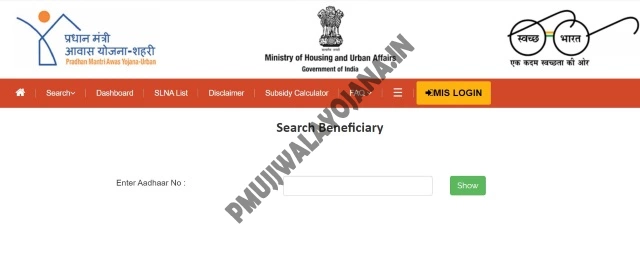
Step 3: On another page enter your registered mobile number and click on the “Send OTP” button.
Step 4: Enter the OTP and click on the “View” button to complete the process.
Check Application Status
To check the application status, follow the steps below:
Step 1: Visit the official website.
Step 2: On the homepage click on the “Track Status” option or click on the link given below
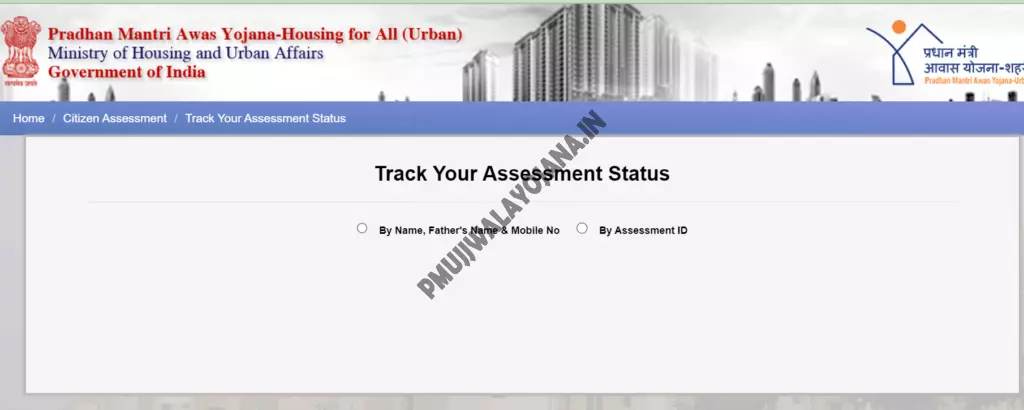
Step 3: A new page will appear on your screen, you will be given two choices whether you want to check the status with “Name, Father’s Name & Mobile No”, or “Assessment ID”.
Step 4: If you select to check the status by father’s name the applicant must enter their state, district, father’s name, mobile number, and city name.
Step 5: If the applicant chooses assessment ID the applicant must enter their assessment ID and mobile number.
Step 6: After entering all the details click on the “Submit” button to complete the process.
Contact Details
- Address: Joint Secretary & Mission Director (Housing for All) Ministry of Housing and Urban Affairs Government of India, Room No. 116, G-Wing, Nirman Bhawan, New Delhi
- Tel: 011-23061419/ 23061420
- Email ID: jshfa-mohua[at]gov[dot]in
FAQs
What is Pradhan Mantri Awas Yojana Urban 2.0?
It is a government initiative aimed at providing affordable housing for urban poor, including Economically Weaker Sections (EWS), Lower Income Groups (LIG), and Middle Income Groups (MIG).
Who is eligible to apply?
Individuals from EWS, LIG, and MIG categories with specific annual income limits are eligible. EWS: up to Rs. 3 lakh, LIG: Rs. 6 lakh, MIG: Rs. 9 lakh.
Is there any application fee?
No application fee is generally charged for applying under PMAY-U 2.0.
How will the subsidy be provided?
The subsidy is credited directly to the beneficiary’s loan account in installments.
What happens after I submit my application?
Your application will be reviewed, and if eligible, you will receive an approval notification along with further instructions.
Can I track my application status?
Yes, you can track your application status through the official website.